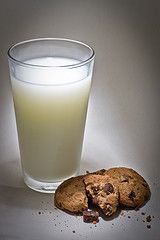
The
majority of the world's people become lactose-intolerant as they mature
into adulthood. The exceptions are mostly people of European ancestry,
who continue to drink milk all their lives. Why? It's a case of genetic
mutation, in which an adult continues to produce lactase, the enzyme
that digests the milk sugar lactose. But why did the mutation become so
prevalent in the population so quickly (about 20,000 years)?
Evolutionary geneticist Mark Thomas says there had to be something about
drinking milk in Europe that led to increased chances of survival or
higher fertility. Here are a couple of possibilities:
First,
the farmers that settled there came from the Fertile Crescent, and they
brought crops native to that region, like wheat and barley. But with
Northern Europe's shorter growing season, these crops were more likely
to fail, causing famine.
Additionally, the colder Northern
European climate lent itself to natural refrigeration. "If you're a
farmer in Southern Europe, and you milk a cow in the morning and you
leave the milk out, it will be yogurt by noon. But if you do the same
thing in Germany, it'll still be milk," says Thomas. A healthy
lactose-intolerant person who drank that still-fresh milk would get a
bad case of diarrhea. "But if you're malnourished, then you'll die,"
Thomas says.
In times of famine, milk drinking probably
increased. And the very people who shouldn't have been consuming
high-lactose dairy products — the hungry and malnourished — would be the
ones more likely to drink fresh milk. So, with milk's deadly effects
for the lactose intolerant, individuals with the lactase mutation would
have been more likely to survive and pass on that gene.
Read more about lactose-tolerance at
NPR.
 The
majority of the world's people become lactose-intolerant as they mature
into adulthood. The exceptions are mostly people of European ancestry,
who continue to drink milk all their lives. Why? It's a case of genetic
mutation, in which an adult continues to produce lactase, the enzyme
that digests the milk sugar lactose. But why did the mutation become so
prevalent in the population so quickly (about 20,000 years)?
Evolutionary geneticist Mark Thomas says there had to be something about
drinking milk in Europe that led to increased chances of survival or
higher fertility. Here are a couple of possibilities:
The
majority of the world's people become lactose-intolerant as they mature
into adulthood. The exceptions are mostly people of European ancestry,
who continue to drink milk all their lives. Why? It's a case of genetic
mutation, in which an adult continues to produce lactase, the enzyme
that digests the milk sugar lactose. But why did the mutation become so
prevalent in the population so quickly (about 20,000 years)?
Evolutionary geneticist Mark Thomas says there had to be something about
drinking milk in Europe that led to increased chances of survival or
higher fertility. Here are a couple of possibilities:
No comments:
Post a Comment